Listen to the first part of this article here:
Somali-inhabited regions in East Africa, including parts of Somalia, Ethiopia, and Kenya, have long been plagued by recurring droughts and periods of water scarcity. These challenges have led to severe consequences for the local population, including food insecurity, loss of livelihoods, and displacement. The primary sources of water for people and animals in these regions are rivers, shallow wells, and boreholes. However, these sources are often insufficient to meet the growing demand for water, particularly during prolonged dry spells. Rainwater harvesting (RWH) is one solution of many to lessen the impact of water scarcity. Our goal with this article is raising awareness and promoting sustainable water management practices. Let’s take a look at it.
Rainwater Harvesting
RWH is the practice of collecting and storing rainwater for future use. It involves capturing rainfall from rooftops, pavements, and other surfaces and storing it in tanks, cisterns, or underground storage systems. The collected water can be used for various purposes, including drinking, irrigation, and livestock watering. RWH has been successfully implemented in many parts of the world, including arid and semi-arid regions, where water is scarce. As a matter of fact, it even has a long history in Somalia as well.
FAO-SWALIM (the organization referred to in admittedly almost every article on this website so far) has published a great, lengthy report regarding the potential of rainwater harvesting in 2007 (SWALIM, 2007 report). We will talk about many of the key elements in this article.
RWH offers various opportunities for communities to improve their livelihoods.
- For example utilizing runoff water to improve human health, as rainwater collected from roofs and rock catchments is relatively clean and safe.
- RWH can also improve agricultural productivity, leading to improved food security.
- Implementation of RWH projects creates job opportunities for locals
- RWH works in conjunction with other water sources, complementing their availability. Its infrastructure is often located near the points of utilization, which saves energy and time.
- RWH also acts as a mitigation measure against the adverse impacts of climate change. By storing water during floods, it prevents damage in low-lying areas and becomes a valuable resource for irrigation and livestock production during dry periods.
With these examples of utilities, we see no reason why RWH is not practiced more widely. According to the aforementioned report, it is mostly practiced by NGOs.
Somalia has been harvesting rainwater forever
Indigenous RWH technologies like berkads and waro have long been utilized in Somalia for domestic, livestock, or crop use. Back them, people would traditionally embarked on long-distance migrations with camels to find water and fodder for their animals. But the introduction of berkads, which are privately owned reservoirs, increased settlements were seen.
Berkads
The construction of berkads began in the 1950s. The concept was introduced by an individual named Xaaxi in 1952, who built the first berkad near Odweyne. It is likely that the idea was inspired by existing examples in Sudan during that time. Major construction of berkads commenced in 1964. As more people settled in the Haud region, the demand for water significantly increased, leading to a period of intense construction. However, the civil war between 1988 and 1991 disrupted construction activities. Today, most of the concrete berkads have cracks, and the quality has been bad since the 1980s when they started getting built faster and cheaper.

Construction of berkads
To minimize water loss through infiltration into the groundwater, the walls and bottom of berkads are typically constructed with bricks and may be coated with cement creating a barrier so water doesn’t seep out. At the top, berkads are sometimes covered with a canvas to reduce evaporation, but often they are open and excreta and other foreign particle contamination is high leading to sanitation issues and diseases. In poorer villages, nets are often used, and materials like branches or straw are placed on top to provide shade and further reduce evaporation (Source).
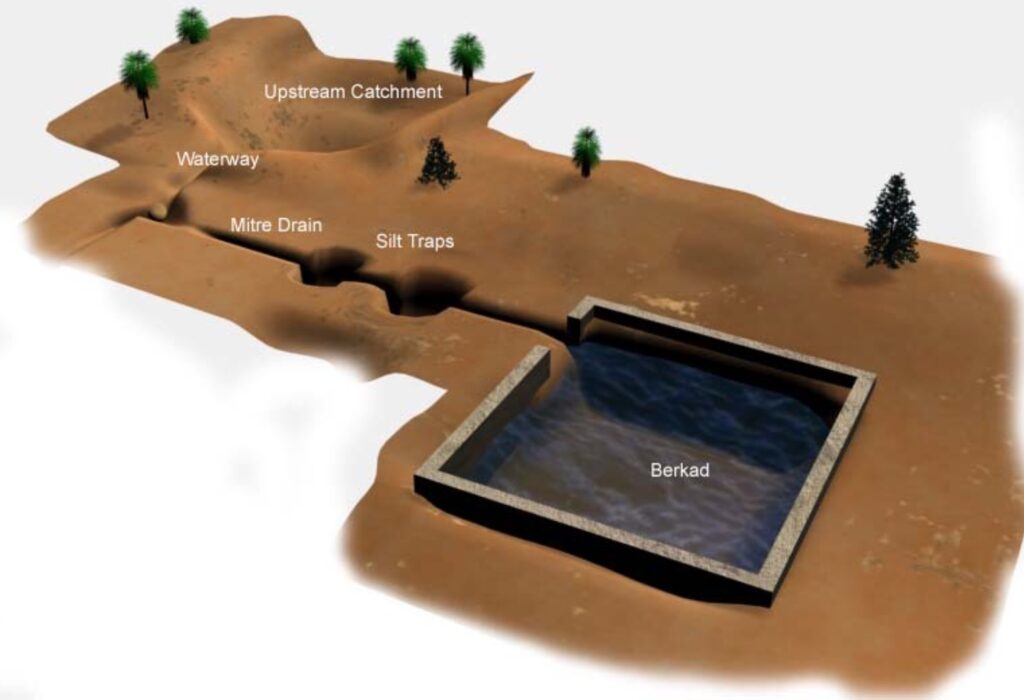
Berkads have a similar size, depth and shape as swimming pools. To improve water quality in berkads, a catch-pool is typically implemented at the inlet of the reservoir which allows the water to flow through before entering the main berkad basin and facilitate the settling of transported sediment and the removal of other contaminants, helping to improve water clarity. A conveyance system can also be built to avoid silt being washed into the berkads.
To see the best design considerations, check the details in the SWALIM 2007 report.
Place and price
In 2001 there were over 7000 berkads in the Haud region alone, so we estimate there are 10s of 1000s of Berkads all over Somalia. A full berkad has the capacity to store water for up to 250 people for six months without requiring additional rainfall.
The price to build a berkad back in 2007 was 1500-3000 USD. The price of buying water varied greatly but an example is 0.4 USD per 20 litre jerrycan (SWALIM 2007). The main advantage is the water is less salty than the shallow water wells. However 50% of all berkads malfunction within 5 years due to poor maintenance which itself can cost 70-80% of the original construction price.
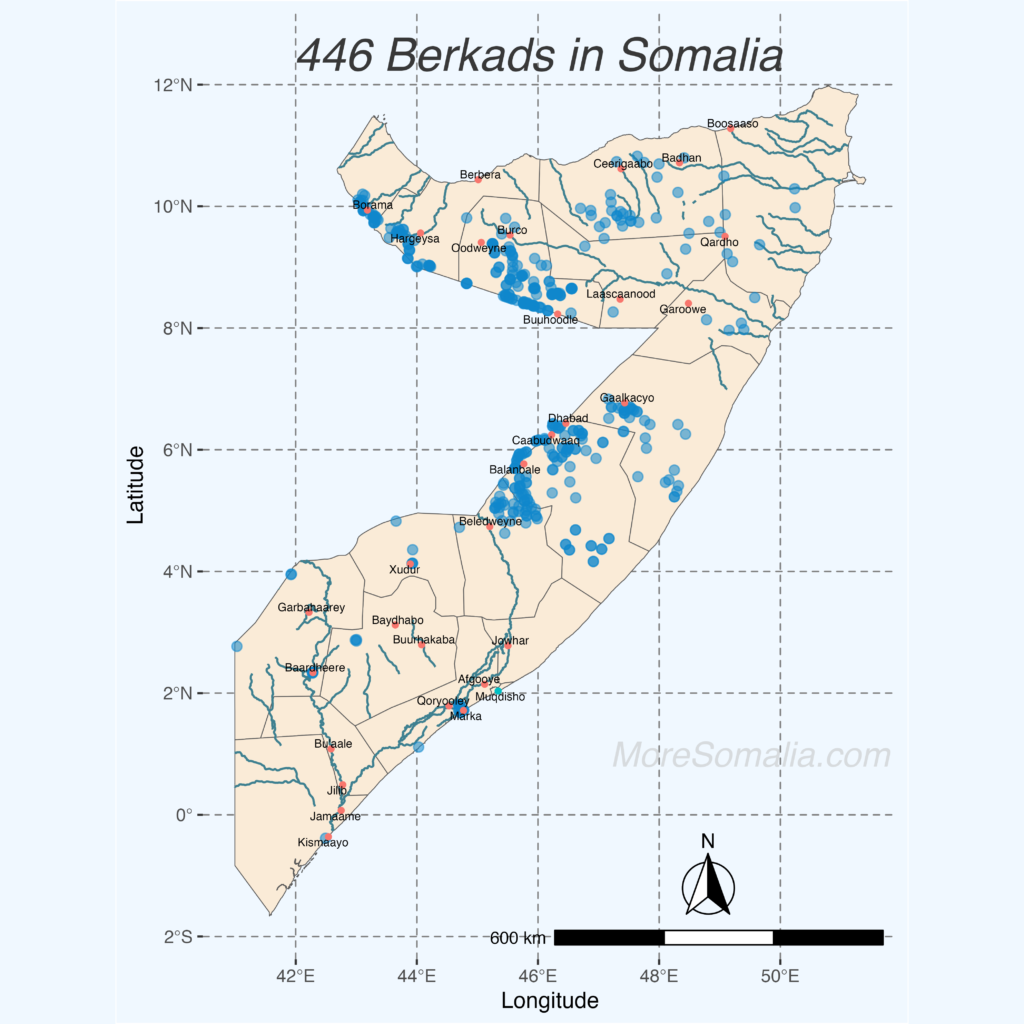
Berkads are strategically placed in locations where small streams are formed during rainfall. These streams are directed to the berkads through dug trenches, allowing them to fill naturally during the rainy season. The filling process can be relatively quick, with some berkads filling up in just a few hours. In villages with limited water availability, feed channels may extend for several kilometers and take the form of properly constructed canals coated with cement or covered. Berkads are often clustered together, creating a network of water storage structures in close proximity. Settlements often arise around these berkads, increasing the population clusters.
Choose among the many techniques based on your goal
The type of RWH you want depends on the aim. There are 3 types of categories:
- Domesting harvesting: Water for drinking, food, sanitation, washing clothes etc. Here you can use direct rainwater or groundwater. Here rainwater is collected from the roof of the house and stored concrete tanks (Berkad guri). Alternatively shallow wells can also be used.
- Livestock production: Here you can collect runoff into either natural depressions or man-made reservoirs (berkads, ponds, and dams). groundwater can also be used. There’s a large overlap with the former category.
- Crop production: More natural conservation techniques can be used here. e.g. Local soil conservation, earth dams, ponds, and other reservoirs from direct runoff. Floodwater from the shabelle and juba rivers are very useful here, thus this is more popular in southern Somalia.
Rainwater
The 1st part of rainwater harvesting is the rainwater itself.
Where does it rain?
It doesn’t rain very much in Somalia, and the ground is therefore referred to as “semi-arid” to “arid” climate depending on where you are. The closer you get to the tip of the horn, the less it rains, as you can see in the rainfall map. Ethiopia receives way more rain, especially in the Western part where they exceed Somalia’s rainfall by over 5X!
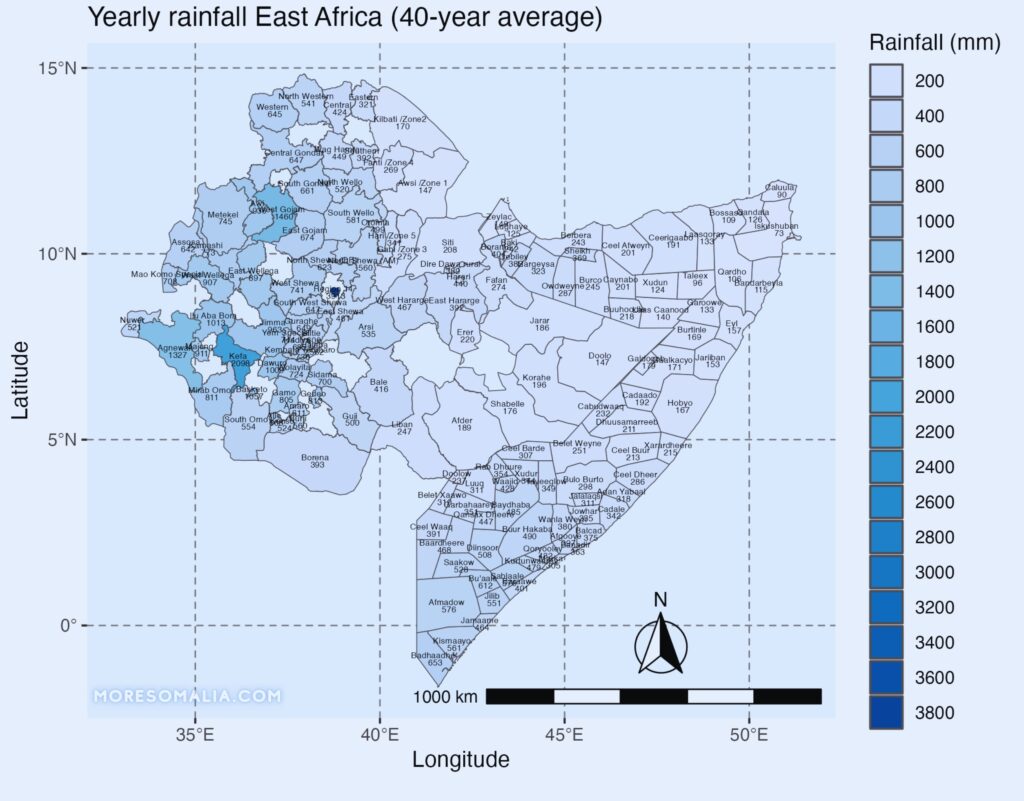
When does it rain?
In Somalia, it usually rains during the rainy seasons called “gu” (March-May) and “deyr” (October-december).
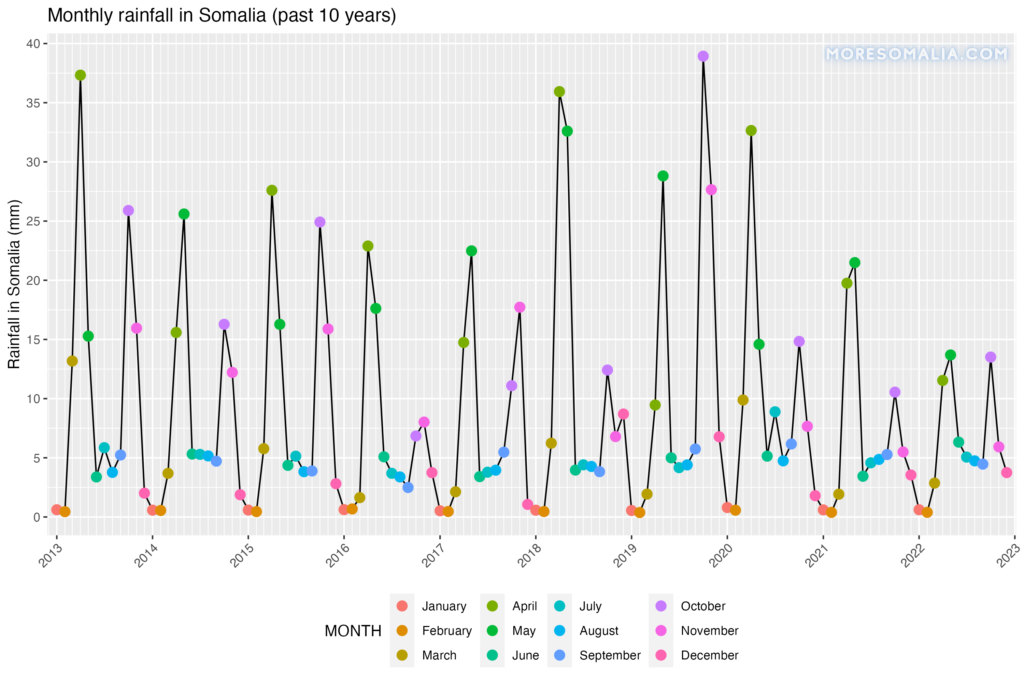
Factors influencing rainwater harvesting
Evaporation, temperature, wind, and elevation all have important roles to play in RWH
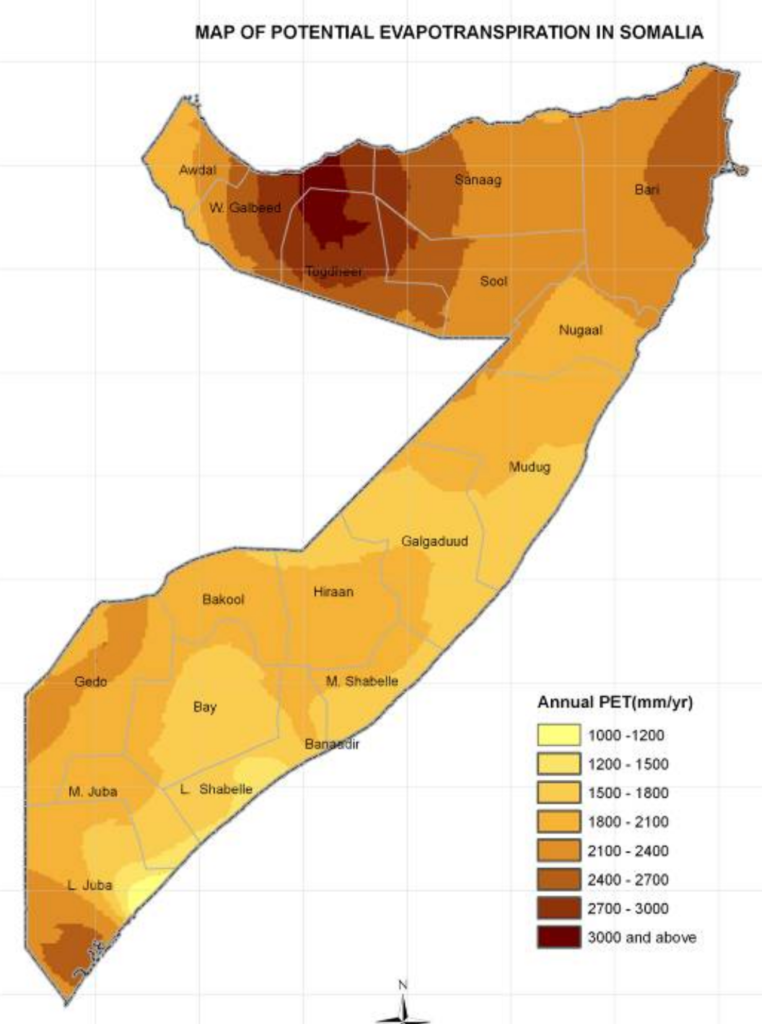
The issue in Somalia is the very high evaporation of the rain. Evapotranspiration (evaporation of water and from plants) is so high, it exceeds rainfall in all regions! The lowest is 1000 mm in Lower Juba area, whereas in the north as much as 3000 mm evaporates every year! Areas with higher rainfall and lower evaporation is best suited for RWH.
Higher temperatures and stronger wind speeds contribute to increased losses from evaporation. To minimize these losses for open water bodies, one effective measure is to plant wind-breaking trees on the side of the reservoir. This strategic placement of trees helps reduce the impact of wind and, consequently, mitigates the rate of evaporation.
Elevation
The elevation of the land and vegetation also plays a major role.
Steeper or longer slopes generally result in increased runoff compared to flatter terrain. This is because on steeper slopes, water flows more rapidly due to the force of gravity, leading to a higher volume of runoff. Steeper slopes have a greater inclination, causing rainfall to quickly flow downhill and generate more runoff. Additionally, longer slopes provide a longer path for water to travel, allowing more time for runoff to accumulate.
On the other hand, flatter terrain allows water to infiltrate into the ground more easily, reducing the amount of surface runoff.
It’s important to note that other factors, such as soil type, vegetation cover, and rainfall intensity, also influence the runoff generation process.
Slopes in Somalia are relatively mild and not excessively steep. As a result, the amount of runoff generated from rainfall events in Somalia is likely to be moderate compared to areas with more pronounced elevation gradients.
Vegetation
The actual type of the land also plays a role in RWH. In areas with a lot of rainfall the ground has more biomass and therefore a more dense vegetation cover. Here you will see more rainwater interception, retention and infiltration and less runoff. However if the vegetation cover is ruined by e.g. soil erosion and deforestation, that will in contrast increase the runoff of the water. So which case is the best? Well, if the soil has poor infiltration capacity, then you can use that for runoff-based systems where you guide the water to another place. If, however, there is good infiltration and the ground can hold on to the water, you can use it for local water conservation.
Harvesting techniques
Barkads may be among the simplest RWH techniques, but it is not the best. There are many other approaches to RWH one can take.
| Cement water tank/ Underground water tank: | Berkad | Subsurface dam: | Doox xidh |
| Roof water tank: | Berkad Guri | Natural ditch: | Dhiijan |
| Roof water harvesting from roof: | Majaroor | Flood channel/diversion: | Deshek |
| Underground reservoir: | Ceel/Mugsid | Natural water course: | Tog |
| Bund: | Naxaroor/Xadhig | Natural depression: | Gal |
| Water pond/earth dam: | Balley | Natural water pond: | Balli |
| Well: | Ceel | Water pond/earth dam: | Xurfad/War |
| Spring: | IL |
Regardless of which approach you choose, RWH comes with great benefits:
- It reduces your reliance on traditional watersources. This means you arent dependent on river water, shallow- or borehole wells which is shared among many people and come with each of their own issues (contamination, overexploitation, lack of predictability)
- By practicing RWH, you have readily access to water, especially during dry periods (as long as your water storage system doesn’t run dry).
- You can control your water usage more freely, and use it for drinking/cooking, sanitation, or even in an agricultural business.
- Mitigate climate change – it is no secret that the weather in Somalia has become more extreme, and prolonged periods of drought but also big floodings are occuring. Through RWH you will likely have an advantage.
So why isn’t everyone doing it?
Well, RWH is not easy nor is it without any challenges.
- Firstly, not everyone is aware of all the benefits it can provide. In Somali inhabited regions, it either rains a lot making RWH easier, or it rains very little thereby creating a huge need for RWH. Either way, people need to know exactly how to engage in this (relatively simple) practice. This can be done through campaigns by policy makers and environmentalists. Everyone has access to the internet, so this needs to be used for educating the people.
- Lack of financial resources: RWH can be costly initially. A berkad for example costs thousands of USD. Not everyone can finance this or take such investment risks.
- Limited technical knowledge: It requires great skills to plan and build any of the harvesting techniques. And you have to build them in high quality, otherwise maintainance will be very costly. We saw earlier, that the quality of the Somali Berkads have decreased in the past years, and many of them are broken. We need more training programs, workshops, and technical assistance in this section.
- Lack of government support: The government needs to help people in RWH. This will reduce drought, and thereby money for preventable humanitarian catastrophes that come with drought. It will also decrease the reliance on donations from abroad, and make the Somali people more independent and financially strong, which in turn will benefit the governments. There will be better focus on growth. Currently the Somali government is going to invest a lot into deep groundwater. This is a great step in the right direction
A personal consideration:
People generally follow the freshwater sources. Through creating the geographical maps on this site over the past few articles, this has become increasingly obvious. There is a balance in nature, and it is easier to go to the water source, than to modify nature and gather water to places where freshwater isn’t really naturally occuring. The latter is resource intensive, and unpredictable in the long term. If it is not easy to settle in areas with more naturally occurring rainwater/freshwater, then RWH is the 2nd best solution. This requires great care, and since droughts can last for years, drying up water sources in the process, one should have a plan B for getting water.
Conclusion
Rainwater harvesting is a good solution to address the drought and water scarcity issues that the Somalis in Somali inhabited regions of East Africa are facing. Although this practice has been used for a very long time, every Somali needs to know about it and how they can utilize and store the rainwater to benefit themselves. Climate change is making Somalia drier and the weather more extreme. There is great personal, regional, and national benefit to RWH both financially, health-wise, and practically. So let’s raise the awareness. And if you are planning to collect some rainwater, please share how.
This article was written as a collaboration between MoreSomalia and Mohamed Omar.


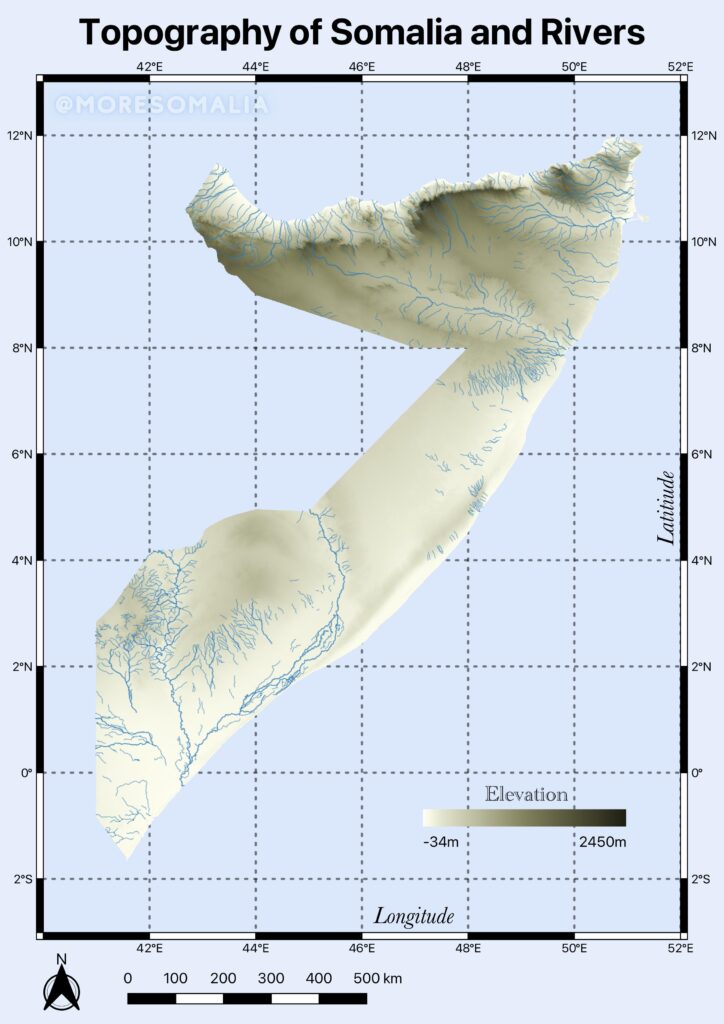
[…] harvesting (see the article post here): We have also written extensively about rainwater harvesting techniques. Somalia has actually been […]